Valdera
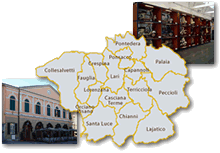
The Era, a tributary of the River Arno, for more than fifty kilometres marks the course of a fertile valley dotted with towns of medieval origin. For centuries contended by Florence, Pisa and Volterra, with the birth of the Grand Duchy, the Valdera became a tranquil rural district which, only as of the 19th century, witnessed a progressive transformation in the manufacturing and industrial sense.
Pontedera constitutes the gate of access to the valley and the principal economic centre of attraction for the entire area. It is, in fact, home to one of the oldest and most important motor industries of Italy: Piaggio.

Conceived by Giovanni Alberto Agnelli and designed by Andrea Bruno, the Museum was inaugurated on March 29, 2000, and is an integral part of the conservation programme of the company historical memory. Promoted by the Piaggio Foundation, the exhibition is set up in the former Piaggio Tooling Department, one of the oldest warehouses of the Pontedera factory.
The collections are made up of three nuclei: the Vespa Collection (prototypes, series models and special versions of the scooter, produced from 1945 to today); the Gilera Collection (motorcycles built from 1909 to the 1990s); the Piaggio Collection (exemplars of the aeronautical, railway, motors and moped production, from 1936 to today). These collections document not only the company’s development but also the changes in Italian taste and customs.
The rich "Annalisa Bechi Piaggio" Historical Archive, visitable on request, collects all the company documentation on paper from its foundation to today, in addition to a rich photographic, audiovisual, presentational and promotional film footage documentation.
(Francesco Marchetti)
Precisely a visit to the factory’s historical collections begins an itinerary that will lead to Capannoli, located about 12 km to the south and accessible via SS439/SR439, where the Museo Civico Zoologico in the eighteenth-century Villa Baciocchi conserves a unique collection of taxidermied animals.
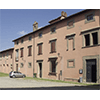
Founded in 1997, the Museum and an Archaeological Documentation Centre are housed in the eighteenth-century Villa Baciocchi. An essentially educational itinerary unfolds through five rooms which exhibit taxidermied animals: invertebrates, mammals, birds, reptiles and fish from all over the world. There is also a bird collection, purchased in 2000, containing several late nineteenth-century specimens and other finds, purchased by the Commune of Capannoli, including a collection of butterflies.
The garden of Villa Baciocchi was conceived in the second half of the 19th century by Luigi Bellincioni who gave the park neo-Gothic buildings, rustic grottoes, and small frescoed aedicules. Today, its 12 monumental trees have legends that illustrate their characteristics. It also presents century-old bamboos, yews and Canadian sequoias. Overall, the garden has more than 160 species of various origins.
(Francesco Marchetti)
Proceeding south and taking SP26 and SP13 in sequence, after about ten kilometres, we reach the centre of the valley, location of the spa area of Casciana, famous for centuries for its curative waters.
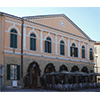
The Baths of Casciana, known already to the Romans, took on new life in the 11th century thanks to Matilde di Canossa, who, it seems, benefited by their curative properties. In 1311 the Podestà of Pisa, Federico da Montefeltro, had a real thermal establishment built. An interesting description of the waters is found in the Tractatus de Balneis (1417) by Ugolino da Montecatini, who resided in Pisa for many years. He visited both Casciana and San Giuliano, and of these places he had "long experience". The waters of Casciana, wrote Ugolino, "are highly beneficial to weak persons and for treating disorders of the digestive system".
The baths were rebuilt in 1621, but later underwent a period of decline. In 1742, in fact, Giovanni Targioni Tozzetti noted that "in the waters of these neglected baths, many frogs live happily". Various remodelling initiatives were carried out, first by Grand Duke Peter Leopold, around 1780, and then by his successor Ferdinand III, in 1824. In the 19th century – as reported by Emanuele Repetti – there were "two large baths, for the two sexes, in the midst of the ancient crater flanked by spacious calidariums". The discharge of the water was also used to drive millstones owned by the Bishops of Volterra. In 1826 the Florentine chemist Giuseppe Gazzeri subjected the waters to chemical analysis. Like many other thermal centres in Tuscany, Casciana flourished in the late 19th century and the early 20th, when it was known by the glamourous name of "Italy's thermal pearl". Still today the Baths of Casciana are a renowned centre of wellness and thermal treatments.
(Graziano Magrini)
Not far away, on the same route, we finally reach Santa Luce where the four thematic itineraries of the Ecomuseo dell'Alabastro will allow visitors to get acquainted with the techniques and procedures tied to milling this material used since the Etruscan epoch.
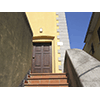
The Ecomuseum of Alabaster proposes four thematic itineraries (the Alabaster Excavation Itinerary, the Manufacture and Marketing Itinerary, the Central Museum Station in the former Palazzo Opera Pia of Castellina Marittima and the Area Archives in Santa Luce), which principally develop in the Communes of Castellina Marittima, Santa Luce and Volterra.
Located in the former Town Hall, the Museum Station of Santa Luce presents work tools, iconographic material and alabaster artefacts. Along the Marmolaio stream, which constitutes a border area between the communities of Castellina and Santa Luce, lies the only still existent tunnel quarry of "Scaglione" (one of the best qualities of alabaster), which has been adapted to conform to regulations and is used for quarrying and tourist visits.
(Graziano Magrini)
Take SP37 up to SS206 and proceed northbound until you come to two junctions. If you take the first, you will see the beginning of the grandiose Leopoldino Aqueduct which, from the early 19th century until 1912, assured water supply to the city of Livorno.
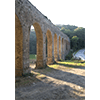
Livorno’s population increase in the course of the 18th century made a new aqueduct necessary, in substitution of the one built by Giovanni del Fantasia under the government of Ferdinando I de’ Medici. Grand Duke Peter Leopold of Lorraine entrusted the commission to Francesco Bombicci who presented a very ambitious project, which was also very costly. So it was that in 1792, the new grand duke, Ferdinando III entrusted the work to Giuseppe Salvetti from Florence, who proposed a new, less expensive solution that provided for a course through the hills, from the sources of Colognole to Livorno.
Work came to a standstill, first due to French occupation (1799) and then for the death of Salvetti himself (1801). In 1806, Queen of Etruria Maria Luisa approved the project of architect Calocchieri which aimed to conclude the work in the most economical form. The construction site was thus reopened under the direction of Ranieri Zocchi, a student of Salvetti’s. In 1809, direction passed to Pasquale Poccianti who finally brought water to Livorno on May 30, 1816 (from then until 1912, this aqueduct was the city’s principle means of water supply). Poccianti also assured maintenance with a series of works. Worthy of mention are the three large cisterns (Little Cistern of Pian di Rota, Little and Large Cisterns of Livorno) that purified the water along its course, guaranteeing an adequate distribution. In 1858, Poccianti died and was replaced by his student Angiolo della Valle, under whom the great work was completed soon after the unification of Italy.
Today it is possible to follow the fascinating route of the impressive aqueduct, which measures about eighteen kilometres, through the woods and hills of Livorno, encountering fifteen series of arches, small polygonal-shaped aedicules for the purification of the water, tunnels and cisterns.
(Graziano Magrini)
If you instead take the second junction, the road runs along lengthy tracts of the aforementioned aqueduct and continues on to the Little Cistern of Pian di Rota, a fine example of neoclassical architecture.
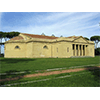
The neoclassical "Cisternino" of Pian di Rota is also known as "Purgatory in Pian di Rota" for its function of filter and collector of waters. Completed in 1851 on a project by Pasquale Poccianti and sited in the lush countryside, the building is quadrilateral in shape and has two semicircular apses on the sides. The facade is lightened by a portico surmounted by a pediment. Two inscriptions in Latin on the facade recall that the work was begun under Grand Duke Ferdinando III of Lorraine and terminated under his successor Leopold II. In 1852 it was filled with water from the springs of Colognole. Continuing along the canalizations over the arches, the water reached the "Cisternone" of Livorno.
(Graziano Magrini)
****************************
Texts by Elena Fani
English translation by Victor Beard
Last update 09/feb/2008



 = libraries and archives
= libraries and archives  = scientific research centers
= scientific research centers  = memorial places of scientists
= memorial places of scientists = public health places
= public health places = places of science and worship
= places of science and worship = places of technology
= places of technology  = museums and collections
= museums and collections  = villas and gardens of science
= villas and gardens of science



